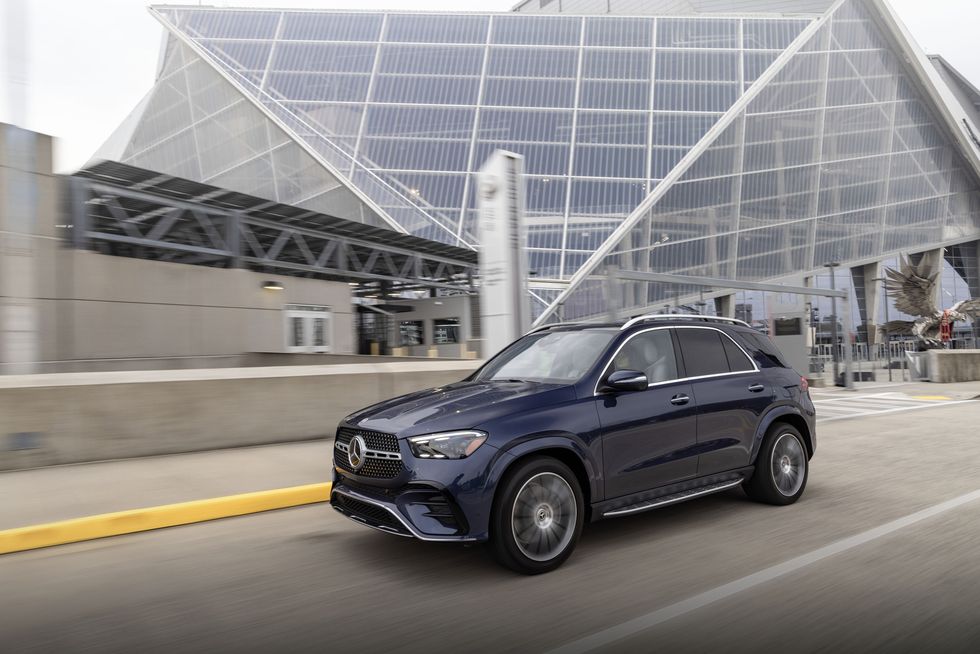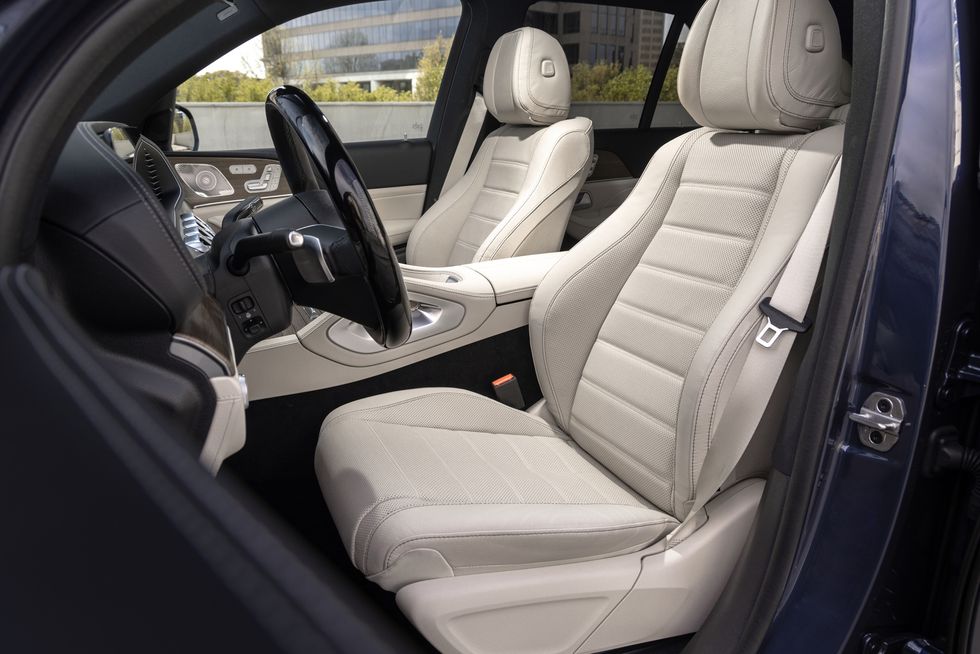2024 Mercedes-Benz GLE450e Finally Fills the Gap

Mercedes-Benz has been preoccupied with high-profile EV introductions and shuffling the attendant corporate EV-nomenclature strategy for the future. But while the automaker’s agenda to become an EV-only concern by 2030 continues to dominate headlines, it quietly slipped the Mercedes-Benz GLE-class 450e plug-in hybrid (PHEV) into its U.S. mid-size SUV lineup for 2024 with little fanfare.
This isn’t the GLE’s first foray into the world of plugs. For a couple of years now, the GLE350e and GLE350de gas and diesel PHEVs, as well as the smaller GLC PHEV, have been available to Europeans. Select versions of both plug-ins were earmarked for earlier North American debuts, but word is that European demand proved so strong they’ve been in a holding pattern. As a consolation prize, the standard GLE450 has utilized a 48-volt hybrid system since 2020, but the new 2024 GLE450e is the first GLE model sold here with a plug-in-hybrid powertrain and a significant electric range.
Mercedes-Benz
The GLE is the second-bestselling model line in Mercedes’s stateside roster behind the compact GLC, and the 2024 GLE450e joins the returning GLE350, GLE450, and GLE580 models, which use turbocharged four- and six-cylinder and V-8 powertrains, respectively. For 2024, the 48-volt hybrid-assist previously standard on the GLE450 and GLE580 models extends to the GLE350 as well. All-wheel drive is standard across the board. The Mercedes-AMG GLE53 and GLE63 S models are still in play, too, and we’ve reviewed them separately.
As for the 2024 GLE450e’s powertrain, the fossil-fuel side of the equation relies on a turbocharged 2.0-liter four-cylinder rated for 248 horsepower and 295 pound-feet of torque. The electric componentry consists of a 134-hp synchronous motor that provides an additional 325 pound-feet of torque, drawing on a lithium-ion battery pack with a usable capacity of 23.3 kWh. The tag team is rated for a combined 381 ponies and 479 pound-feet, placing it above both the GLE350 (255 horses and 295 pound-feet) and the GLE450 (375 horses and 369 pound-feet).
Mercedes pegs the 60-mph time of the GLE450e at 5.8 seconds, a full 1.2 seconds swifter than the automaker’s 7.0-second claim for the GLE350 and just 0.5 second behind the GLE450’s stated 5.3-second time. It’s tempting to think of the 2024 Mercedes-Benz GLE450e PHEV as a baby step to the electric future or as a placeholder for drivers who remain skeptical regarding the promised EV Babylon. And without a doubt, it is both of those things.
But the GLE450e is also a fully baked PHEV that operates with seamless precision in any environment while ensconcing its passengers in the same level of luxury and features as the rest of the GLE lineup. It’s tranquil at any speed, largely thanks to the dogged persistence with which the software favors electric operation in nearly every driving situation. In town, on the highway, or on the rural two-lanes of the Smoky Mountains, the GLE450e displays remarkable restraint, dialing in assistance from the internal-combustion engine only when absolutely required. Indeed, my co-driver and I engaged in quiet conversation for a long enough time that we were startled when the four-cylinder fired up to aid the nearly depleted battery.
Official EPA fuel-economy and range estimates for the GLE450e are pending, and Benz officials were cagey about nailing down a firm EV-only range number. Still, in our hands, the GLE450e covered an indicated 43 miles of electric range during combined city and rural driving in a decidedly typical driving fashion.

Mercedes-Benz
All the fundamental GLE driving dynamics remain: It feels smaller and more agile at the helm than its footprint suggests, and the ride is cushy. But our car’s 21-inch AMG wheels, as part of the AMG Line appearance package, ensure that significant road imperfections do not pass unnoticed. The electric motor provides eager acceleration from a stop with the slightest throttle input; jumping into the PHEV from a traditional GLE requires a little readjustment to avoid leaping away from a stoplight. It’s a rock at or above highway speeds and, like its siblings, has an electronically limited 130-mph top speed.
Unfortunately, the regenerative properties of the GLE450e left us wishing for a little more refinement in the brake pedal and a bit more productivity in the recharging department. Manufacturers have been wrestling with dodgy pedal feel and uneven braking action for as long as hybrids have been a thing, and the GLE450e still struggles. But the amount of reclaimed energy—or lack thereof—as indicated by the battery status indicator on the instrument panel has us scratching our heads.
Like most hybrids and PHEVs, regeneration occurs when braking or coasting as directed by the software, with two different regen levels selectable via the wheel-mounted shift paddles. The first setting provides mild regen; the second increases regeneration and will bring the vehicle to a stop—pretty standard stuff.

Mercedes-Benz
But it’s worth noting that we barely managed to nudge the juice meter during a nearly 3500-foot descent down the mountain to approximately 761 feet above sea level. An anecdotal observation, to be sure, but getting something for “nothing” is a cheap hybrid thrill that we’ve come to expect. We’ll explore this observation in depth when we get a GLE450e to test in-house.
The GLE450e comes equipped with an 11.0-kW AC and a 60-kW DC onboard charger, but no official U.S.-specific charging data is available yet. Cribbing from its European cousin, which specs a slightly larger 31.2-kWh battery, we estimate that the GLE450e should be able to be recharged from 20 to 80 percent in roughly 20 minutes on a 60-kW DC fast-charger. Homebodies looking to restore a fully depleted battery will want to budget up to 26 hours on a standard 120-volt household outlet or just under four hours on a 7.0-kW Level 2 charger. We expect Mercedes-Benz to have the relevant star-spangled figures closer to launch.
Price, too, remains a mystery at this point. We estimate the 2024 Mercedes-Benz GLE450e will start around $76,000, roughly $8K more than the standard GLE450. That’s significantly more than the $56,595 figure for the base Audi Q5 Premium PHEV (though that model fell short of its EPA-estimated 23 EV miles in C/D testing). Furthermore, the Benz feels far more polished in terms of interior materials. The Porsche Cayenne E-Hybrid is also in the mix, but it starts at nearly $90K and has an estimated EV range of only 17 miles. The Volvo XC90 Recharge hews closely to the blueprint of the GLE450e and slides in at just over $70K ($81K for the Recharge Ultimate) with an EPA-estimated 36 miles of EV range (29 miles in C/D testing).
However, the GLE’s real bogey here is the new 2024 BMW X5 xDrive50e (which replaces the X5 xDrive45e). The X5 Drive50e starts at $73,495 and claims up to 40 miles of EV range from its 25.7-kWh battery—it’s almost as if Munich and Stuttgart shared a focus group during development.
As with most PHEVs, the decision is a numbers game. When you consider Benz’s fully electric EQE SUV offers a claimed 253-279 miles of range for $79,050, buyers have the option of sidestepping the PHEV and taking the full EV plunge at a relatively minor upcharge over the GLE450e. On the other hand, if their use cases involve less than 40 miles of driving on a typical day, the PHEV offers the ability to live the EV promise while still providing a gas-powered safety net for longer trips.
The GLE450e is built alongside the rest of the GLE lineup at Mercedes-Benz’s facility in Tuscaloosa, Alabama. Look for the GLE450e to arrive in U.S. showrooms late this summer.
Arrow pointing downArrow pointing down
Specifications
Specifications
2024 Mercedes-Benz GLE450e
Vehicle Type: front-engine, mid-motor, all-wheel-drive, 5-passenger, 4-door wagon
PRICE
Base: $76,000
POWERTRAIN
turbocharged and intercooled DOHC 16-valve 2.0-liter inline-4, 248 hp, 295 lb-ft + permanent-magnet synchronous AC motor, 134 hp, 325 lb-ft (combined output: 381 hp, 479 lb-ft); 23.3-kWh lithium-ion battery pack
Onboard Charger: 11.0 kW
Peak DC Fast-Charge Rate: 60 kW
Transmission: 9-speed automatic
DIMENSIONS
Wheelbase: 117.9 in
Length: 194.3 in
Width: 76.7 in
Height: 70.7 in
Passenger Volume, F/R: 56/51 ft3
Cargo Volume, Behind F/R: 75/33 ft3
Curb Weight (C/D est): 5800 lb
PERFORMANCE (C/D EST)
60 mph: 5.6 sec
1/4-Mile: 14.2 sec
Top Speed: 130 mph
EPA FUEL ECONOMY (C/D EST)
Combined/City/Highway: 24/25/23 mpg
Combined Gasoline + Electricity: 60 MPGe
EV Range: 40 mi

Online Editor
Andrew Wendler brings decades of wrenching, writing, and editorial experience with numerous outlets to Car and Driver. A rust-belt native and tireless promoter of the region, he once won a $5 bet by walking the entire length of the elevated People Mover track that encircles downtown Detroit.





